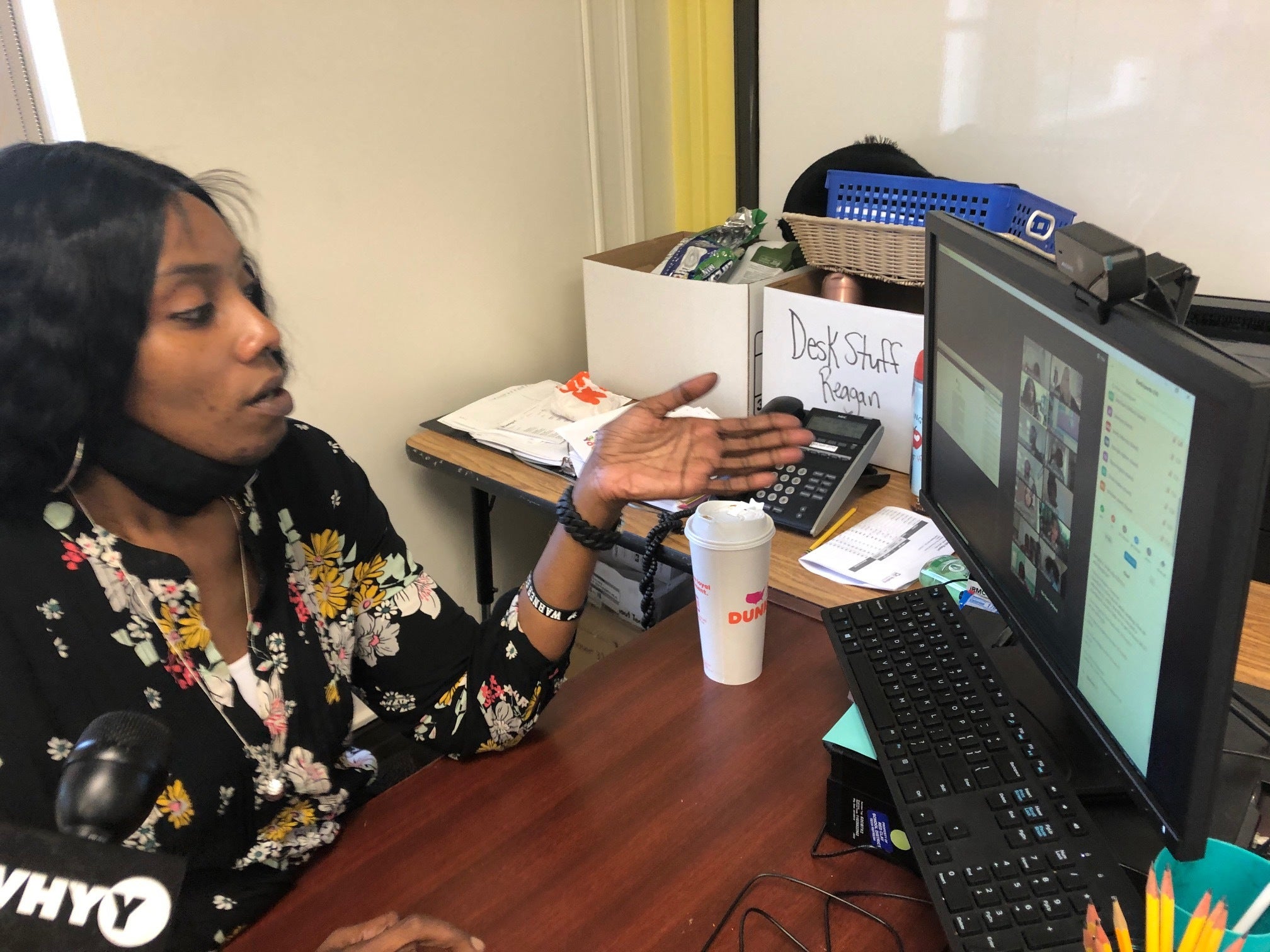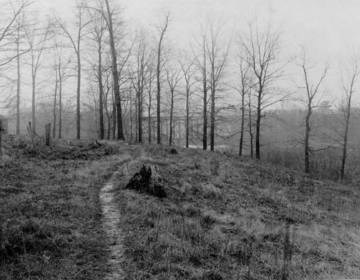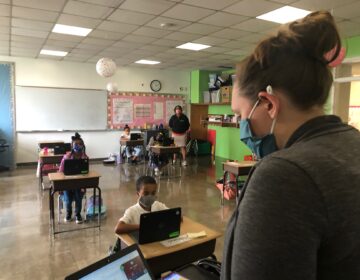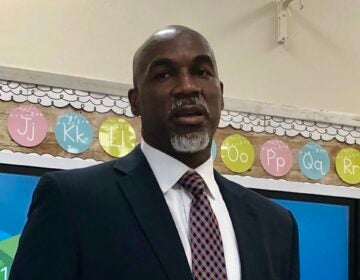Hybrid or remote-only, Delaware teachers ‘trying to find grace to work through it all’
Teaching online only, or doing it with kids in class and at home, is uncharted territory for educators. They’re trying to make it work.
Listen 5:16
Jordan Collings teaches her EastSide Charter third-graders who are in the classroom as well as at home. (Cris Barrish/WHYY)
Jordan Collings addresses two sets of her third-graders at EastSide Charter, getting them logged into the Seesaw online learning platform for math class.
Ten students are in her classroom, wearing masks and separated by at least six feet.
Another dozen are at home, connecting through Zoom.
A handful are absent altogether.
“All right friends, we’re going to get on Seesaw and finish where we were this morning,’’ Collings instructs. “A couple of you have some notes to look back on your assignment, your math problems. You have notes of what you need to fix.”

Collings’ in-class students are among about 30 of the school’s 450 kids whose parents decided to have them don masks and sit far apart to get in-person instruction. She carries a laptop around the room, keeping an eye on those at home while assisting children in front of her.
One is Azariah Hatcher. She’s happy to be in class, the child says, “because I want to learn better instead of doing it on Zoom. I can be face-to-face with my teacher.”
Mikael Crooks can get hands-on help with his division lessons, and besides, he says, “I think it’s like funner in person.”
The hybrid learning scene playing out at EastSide Charter is a rare one in Delaware early in the school year, with the vast majority of public schools using remote-only education as the state’s coronavirus cases remain persistently high.

Nearly 21,000 residents have contracted coronavirus since the first confirmed case in March and 636 have died from related causes. Governor John Carney says kids can’t fully return to class until the average number of daily cases, currently about 118, and positivity rates, about 8%, drop substantially.
So in the meantime, it’s hybrid or remote-only for Delaware students. To witness versions of the two methods currently being used, this week WHYY News visited Wilmington’s EastSide Charter and Warner Elementary, which is teaching all children online. Both schools also face major challenges during normal times because many of their students come from low-income families and struggle to meet academic proficiency standards.
EastSide CEO Aaron Bass says COVID-19 testing is done weekly, visitors’ temperatures are taken at the door, and that the results have been glowing: no one has yet tested positive for the coronavirus. Soon more children and teachers will soon be coming into the building. It’s up to them.
“We think the best thing … is that children are in school with their teachers, so we offered them the choice,’’ Bass said. For those who are attending, “we make sure we’re keeping our children as safe as professional athletes.”
For EastSide’s teachers who choose to give classes in-person, it’s a juggling act that’s also fraught with online connectivity and other issues. Third grade science and reading teacher Natalie Gimbel stifles a laugh when asked how she’s coping.
“Just trying to have a lot of patience with myself, with kids, with parents, with technology, especially with technology,’’ she said. “And taking it one day at a time really and trying to give both parents, students and myself some grace to work through it all.”
She’s also struggling with wearing a face mask all day.
“It’s awful. My mask keeps falling down,’’ she said. “The kids have been really resilient with this, though. Maybe once or twice a day I have to remind them to put their masks up.”

Kindergartner Ellie Freeland was asked if she likes covering her nose and mouth. The girl beams and exclaims, “Yes! Because I can come here.”
Freeland’s teacher, Meagan Gonzalez, uses four different screens with her in-class and online pupils.
“It’s a lot,’’ she said. “It’s not easy doing virtual and in-person at the same time. It’s definitely two jobs that you’re doing at once.”

‘I feel like attendance has been the biggest issue’
Two miles away at Warner Elementary, the hallways are barren.
Warner’s district, Red Clay, is only allowing remote learning for now, although parents are being surveyed to see which ones want to go to a hybrid model — four days a week in class — starting in November with the second marking period.
So on the day WHYY visited, fifth grade teacher Jaela Hall sat alone in her large classroom, delivering her lessons to the small faces on the screen of her desktop computer. Assisting her was a student teacher from the University of Delaware, who was in Boston while she communicated with the children.
Hall would rather have a full classroom, she said, but first wants it to be safe for children to be together en masse.

“I believe the kids, they need to come in every day,’’ Hall said. “They need an area that’s conducive to learning. They need structure and some type of routine. As an adult, it was difficult for me to do that in my own home, so I can’t imagine what the students are going through.”
Six of Hall’s 18 students were absent on the day WHYY was there.
“I feel like attendance has been the biggest issue,’’ she said, adding that it’s not easy for the pupils and their families.
“It’s trying to get students logged on because they also have to go between sessions. They’ll log on for me, but then they also have to log off and go to a math session. Then they have to log off and go to their unified arts. And getting students to come back in the afternoon can sometimes be a challenge.”

But when it’s time to teach language arts, Hall bursts with enthusiasm and encouragement.
After giving the children a lesson in grammar, she moves to a book they are reading and talks about literary devices.
She asks if anyone knows the definition of “illusion” and peers into her screen.
“Darryus, I think I saw our hand. Did I see your hand?” she says.
But then his image vanishes.
“Your screen went out real quick,’’ she says. “Where did he go?”
He reappears a second later.
“OK. I can see you now. What is an illusion?”
“When you think you see something,’’ the boy replied.
Hall rejoices.
“When you think you see something!” she shouts. “Very good! Very good! Very good?”
The kids initially get stumped when she asks what you call it when book characters talk to each other.
“What’s that word called? What’s that word called?” she instructs. “Put it in a chat.”
No one types anything, so she continues prodding.
“They put it in quotation marks. Anybody remember?” she says.
“I think it starts with a D. Di. Di. Di. I see you thinking, Nyaisjah, I see you thinking. No, not quite a diagram. It is a discussion.”
Finally another child figures it out.
“There it is, Marty! Dialogue! Dialogue!’’ Hall cries with a resounding clap of her hands. “That’s what it’s called. Dialogue!”
Once the session ends, Hall takes a breather and says she’s simply figuring out a way to keep the kids engaged even though they’re not in the classroom together.
“But you also have to be realistic,’’ she says, “and realize that this is a very uncertain time and really nobody knows what’s coming up the pike.”
WHYY is your source for fact-based, in-depth journalism and information. As a nonprofit organization, we rely on financial support from readers like you. Please give today.




![CoronavirusPandemic_1024x512[1]](https://whyy.org/wp-content/uploads/2020/03/CoronavirusPandemic_1024x5121-300x150.jpg)


